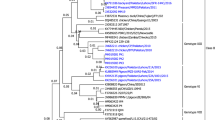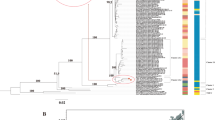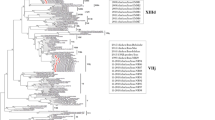Abstract
The disease caused by Newcastle disease virus (NDV) is a severe threat to the poultry industry worldwide. Recently, NDV has been isolated in the Antarctic region. Detailed studies on the mode of evolution of NDV strains isolated worldwide are relevant for our understanding of the evolutionary history of NDV. For this reason, we have performed Bayesian coalescent analysis of NDV strains isolated in Antarctica to study evolutionary rates, population dynamics, and patterns of evolution. Analysis of F protein cleavage-site sequences of NDV isolates from Antarctica suggested that these strains are lentogenic. Strains isolated in Antarctica and genotype I reference strain Ulster/67 diverged from ancestors that existed around 1958. The time of the most recent common ancestor (MRCA) was established to be around 1883 for all class II viruses. A mean rate of evolution of 1.78 × 10-3 substitutions per site per year (s/s/y) was obtained for the F gene sequences of NDV strains examined in this study. A Bayesian skyline plot indicated a decline in NDV population size in the last 25 years. The results are discussed in terms of the possible role of Antarctica in emerging or re-emerging viruses and the evolution of NDV populations worldwide.



Similar content being viewed by others
References
Samal SK (2011) Newcastle disease and related avian paramyxoviruses. In: Samal SK (ed) The biology of paramyxoviruses. Caister Academic Press, Norfolk, pp 69–114
Lamb R, Parks G (2007) Paramyxoviridae: the viruses and their replication. In: Knipe DM, Howley PM, Griffin DE, Lamb RA, Martin MA, Roizman B, Straus SE (eds) Fields virology. Lippicott Williams & Wilkins, Philadelphia, pp 1449–1496
Kim LM, King DJ, Curry PE et al (2007) Phylogenetic diversity among low-virulence Newcastle Disease Viruses from waterfowl and shorebirds and comparison of genotype distributions to those of poultry-origin isolates. J Virol 81:12641–12653
Alexander DJ (2003) Newcastle disease virus, other avian paramyxoviruses, and pneumovirus infections. In: Saif YM, Barnes HJ, Glisson JR, Fadly AM, McDougald LR, Swayne DE (eds) Disease of poultry, 11edn. Iowa State University Press, Ames, pp 63–87
Toyoda T, Gotoh B, Sakaguchi T, Kida H, Nagai Y (1988) Identification of amino acids relevant to three antigenic determinants on the fusion protein of Newcastle disease virus that are involved in fusion inhibition and neutralization. J Virol 62:4427–4430
Neyt C, Geliebter J, Slaoui M, Morales D, Meulemans G, Burny A (1989) Mutations located on both F1 and F2 subunits of the Newcastle Disease virus fusion protein confer resistance to neutralization with monoclonal antibodies. J Virol 63:952–954
Nagai Y, Hamaguchi M, Toyoda T (1989) Molecular biology of Newcastle disease virus. Prog Vet Microbiol Immunol 5:16–64
Samal S, Khattar S, Kumar S, Collins PL, Samal SK (2012) Coordinate deletion of N-glycans from the heptad repeats of the fusion F protein of Newcastle Disease virus yields a hyperfusogenic virus with increased replication, virulence, and immunogenicity. J Virol 86:2501–2511
Panda A, Huang Z, Elankumaran S, Rockemann DD, Samal SK (2004) Role of fusion protein cleavage site in the virulence of Newcastle disease virus. Microb Pathog 36:1–10
De Leeuw OS, Koch G, Hartog L, Ravenshorst N, Peeters BPH (2005) Virulence of Newcastle disease virus is determined by the cleavage site of the fusion protein and by both the stem region and globular head of the haemagglutinin–neuraminidase protein. J Gen Virol 86:1759–1769
Choi KS, Lee EK, Jeon WJ, Kwon JH (2010) Antigenic and immunogenic investigation of the virulence motif of the Newcastle disease virus fusion protein. J Vet Sci 11:205–211
Pedersen JC, Senne DA, Woolcock PR, Kinde H, King DJ, Wise MG, Panigrahy B, Seal BS (2004) Phylogenetic relationships among virulent Newcastle disease virus isolates from the 2002–2003 outbreak in California and other recent outbreaks in North America. J Clin Microbiol 42:2329–2334
Yusoff K, Nesbit M, McCartney H, Meulemans G, Alexander DJ, Collins MS, Emmerson PT, Samson AC (1989) Location of neutralizing epitopes on the fusion protein of Newcastle disease virus strain Beaudette C. J Gen Virol 70:3105–3109
Maminiaina OF, Gil P, Briand FX et al (2010) Newcastle Disease Virus in Madagascar: identification of an original genotype possibly deriving from a died out ancestor of genotype IV. PLoS ONE 5:e13987
Mase M, Murayama K, Karino A, Inoue T (2010) Analysis of the fusion protein gene of Newcastle Disease viruses isolated in Japan. J Vet Med Sci 73:47–54
Czeglédi A, Ujvári D, Somogyi E, Wehmann E, Werner O, Lomniczi B (2006) Third genome size category of avian paramyxovirus serotype 1 (Newcastle disease virus) and evolutionary implications. Virus Res 120:36–48
Diel DG, da Silva LH, Liu H, Wang Z, Miller PJ, Afonso CL (2012) Genetic diversity of avian paramyxovirus type 1: proposal for a unified nomenclature and classification system of Newcastle disease virus genotypes. Infect Genet Evol 12:1770–1779
Fernandes CC, Varanib AM, Lemos EGM, de Miranda VFO, Silva KR, Fernando FS, Montassiera MFS, Montassiera HJ (2014) Molecular and phylogenetic characterization based on the complete genome of a virulent pathotype of Newcastle disease virus isolated in the 1970s in Brazil. Infect Genet Evol 26:160–167
Snoeck CJ, Owoade AA, Couacy-Hymann E, Alkali BR, Okwen MP, Adeyanju AT, Komoyo GF, Nakouné E, Le Faou A, Muller CP (2013) High genetic diversity of Newcastle disease virus in poultry in West and Central Africa: cocirculation of genotype and newly defined genotypes XVII and XVIII. J Clin Microbiol 51:2250–2260
Xiao S, Paldurai A, Nayak B, Mirande A, Collins PL, Samal SK (2013) Complete genome sequence of a highly virulent Newcastle disease virus currently circulating in Mexico. Genome Announc. doi:10.1128/genomeA.00177-12
Chong YL, Padhi A, Hudson PJ, Poss M (2010) The effect of vaccination on the evolution and population dynamics of avian paramyxovirus-1. PLoS Pathog 6:e1000872
Rui Z, Juan P, Jingliang S, Jixun Z, Xiaoting W, Shouping Z, Xiaojiao L, Guozhong Z (2010) Phylogenetic characterization of Newcastle disease virus isolated in the mainland of China during 2001–2009. Vet Microbiol 141:246–257
Zhang S, Wang X, Zhao C, Liu D, Hu Y, Zhao J, Zhang G (2011) Phylogenetic and pathotypical analysis of two virulent Newcastle disease viruses isolated from domestic ducks in China. PLoS ONE 6:e25000
Susta L, Miller PJ, Afonso CL, Brown CC (2011) Clinicopathological characterization in poultry of three strains of Newcastle disease virus isolated from recent outbreaks. Vet Pathol 48:349–360
Afonso CL, Miller PJ (2013) Newcastle disease: progress and gaps in the development of vaccines and diagnostic tools. Dev Biol 135:95–106
Lomniczi B, Wehmann E, Herczeg J et al (1998) Newcastle disease outbreaks in recent years in western Europe were caused by an old (VI) and a novel genotype (VII). Arch Virol 143:49–64
Herczeg J, Wehmann E, Bragg RR, Travassos-Dias PM, Hadjiev G, Werner O, Lomniczi B (1999) Two novel genetic groups (VIIb and VIII) responsible for recent Newcastle disease outbreaks in Southern Africa, one (VIIb) of which reached Southern Europe. Arch Virol 144:2087–2099
Abolnik CHR, Bisschop SP, Parker ME, Romito M, Viljoen GJ (2004) A phylogenetic study of South African Newcastle disease virus strains isolated between 1990 and 2002 suggests epidemiological origins in the Far East. Arch Virol 149:603–619
Yang CY, Shieh HK, Lin YL, Chang PC (1999) Newcastle disease virus isolated from recent outbreaks in Taiwan phylogenetically related to viruses (genotype VII) from recent outbreaks in western Europe. Avian Dis 43:125–130
Perozo F, Marcano R, Afonso CL (2012) Biological and phylogenetic characterization of a genotype VII Newcastle disease virus from Venezuela: efficacy of field vaccination. J Clin Microbiol 50:1204–1208
Diel DG, Susta L, Garcia SC, Killian ML, Brown C, Miller PJ, Afonso CL (2012) Complete genome and clinicopathological characterization of a virulent Newcastle disease virus isolate from South America. J Clin Microbiol 50:378–387
OIE (2011) World Animal Health Information Database (WAHID) Interface. http://web.oie.int
Thomazelli LM, Araujo J, Oliveira DB et al (2010) Newcastle disease virus in penguins from King George Island on the Antarctic region. Vet Microbiol 146:155–160
Edgar RC (2004) MUSCLE: a multiple sequence alignment method with reduced time and space complexity. BMC Bioinform 5:113
Tamura K, Peterson D, Peterson N, Stecher G, Nei M, Kumar S (2011) MEGA5: molecular evolutionary genetics analysis using maximum likelihood, evolutionary distance, and maximum parsimony methods. Mol Biol Evol 28:2731–2739
Drummond AJ, Rambaut A (2007) BEAST: Bayesian evolutionary analysis by sampling trees. BMC Evol Biol 7:214
Delport W, Poon AF, Frost SD, Kosakovsky-Pond SL (2010) Datamonkey 2010: a suite of phylogenetic analysis tools for evolutionary biology. Bioinformatics 26:2455–2457
Drummond AJ, Ho SYW, Phillips MJ, Rambaut A (2006) Relaxed phylogenetics and dating with confindence. PLoS Biol 4:e88
Suchard MA, Weiss RE, Sinsheimer JS (2001) Bayesian selection of continuous time Markov chain evolutionary models. Mol Biol Evol 18:1001–1013
Paldurai A, Kumar S, Nayak B, Samal SK (2010) Complete genome sequence of highly virulent neurotropic Newcastle disease virus strain Texas GB. Virus Genes 41:67–72
Seal BS (2004) Nucleotide and predicted amino acid sequence analysis of the fusion protein and hemagglutinin-neuraminidase protein genes among Newcastle disease virus isolates. Phylogenetic relationships among the Paramyxovirinae based on attachment glycoprotein sequences. Funct Integr Genomics 4:246–257
Drummond AJ, Rambaut A, Shapiro B, Pybus OG (2005) Bayesian coalescent inference of past population dynamics from molecular sequences. Mol Biol Evol 22:1185–1192
Alexander DJ, Manvell RJ, Collins MS, Brockman SJ, Westbury HA, Morgan I, Austin FJ (1989) Characterization of paramyxoviruses isolated from penguins in Antarctica and sub-Antarctica during 1976–1979. Arch Virol 109:135–143
Gould AR, Kattenbelt JA, Selleck P, Hansson E, Della-Porta A, Westbury HA (2001) Virulent Newcastle disease in Australia: molecular epidemiological analysis of viruses isolated prior to and during the outbreaks of 1998–2000. Virus Res 77:51–60
Kattenbelt JA, Stevens MP, Gould AR (2006) Sequence variation in the Newcastle disease virus genome. Virus Res 116:168–184
Alexander DJ (1998) Newcastle disease and other avian paramyxoviruses. A laboratory manual for the isolation and identification of avian pathogens. American Association of Avian Pathologists, Kennett Square, pp 156–163
Alexander DJ (1997) Newcastle disease and other avian Paramyxoviridae infections. In: Calnek BW (ed) Diseases of poultry. Mosby-Wolfe Iowa State University Press, Ames, pp 541–569
Werner O, Römer-Oberdörfer A, Köllner B, Manvell RJ, Alexander DJ (1999) Characterization of avian paramyxovirus type 1 strains isolated in Germany during 1992 to 1996. Avian Pathol 28:79–88
Alexander DJ, Senne DA (2008) Newcastle disease. In: Saif YM, Barnes HJ, Glisson JR, Fadly AM, McDougald LR, Swayne DE (eds) Diseases of poultry, 12th edn. Blackwell Publishing, Ames, pp 75–100
Wakamatsu N, King DJ, Seal BS, Peeters BP, Brown CC (2006) The effect on pathogenesis of Newcastle disease virus LaSota strain from a mutation of the fusion cleavage site to a virulent sequence. Avian Dis 50:483–488
Korber B, Muldoon M, Theiler J, Gao F, Gupta R, Lapedes A, Hahn BBH, Wolinsky S, Bhattacharya T (2000) Timing the ancestor of the HIV-1 pandemic strains. Science 288:1789–1796
Zlateva KT, Lemey P, Moes E, Vandamme AM, Van Ranst M (2005) Genetic variability and molecular evolution of the human respiratory syncytial virus subgroup B attachment G protein. J Virol 79:9157–9167
Allain JP, Dong Y, Vandamme AM, Moulton V, Salemi M (2000) Evolutionary rate and genetic drift of hepatitis C virus are not correlated with the host immune response: studies of infected donor–recipient clusters. J Virol 74:2541–2549
Macpherson LW (1956) Some observations on the epizootiology of New Castle Disease. Can J Comp Med Vet Sci 20:155–168
Miller PJ, Decanini EL, Afonso CL (2009) Newcastle disease: Evolution of genotypes and the related diagnostic challenges. Infect Genet Evol 10:26–35
Nakamura K, Ohtsu N, Nakamura T, Yamamoto Y, Yamada M, Mase M, Imai K (2008) Pathologic and immunohistochemical studies of Newcastle disease (ND) in broiler chickens vaccinated with ND: severe nonpurulent encephalitis and necrotizing pancreatitis. Vet Pathol 45:928–933
Wan H, Chen L, Wu L, Liu X (2004) Newcastle disease in geese: natural occurrence and experimental infection. Avian Pathol 33:216–221
Acknowledgments
We thank Instituto Antártico Uruguayo and Base Científica Antártica Artigas, Uruguay, for encouragement and support. We also thank Agencia Nacional de Investigación e Innovación (ANII) for support through project PE_ALI_2009_1_1603 and PEDECIBA, Uruguay.
Author information
Authors and Affiliations
Corresponding author
Electronic supplementary material
Below is the link to the electronic supplementary material.
Rights and permissions
About this article
Cite this article
Soñora, M., Moreno, P., Echeverría, N. et al. An evolutionary insight into Newcastle disease viruses isolated in Antarctica. Arch Virol 160, 1893–1900 (2015). https://doi.org/10.1007/s00705-015-2434-y
Received:
Accepted:
Published:
Issue Date:
DOI: https://doi.org/10.1007/s00705-015-2434-y




